Every day, we touch our phones over 2,500 times! Unknowingly, in large part, we use our phones immediately often after grabbing door handles, tapping elevator buttons, or handling public money.
Bacteria like E. coli, MRSA, and even viruses like influenza can easily transfer to the things we carry most in our pockets. Disinfecting these items used to require sprays, wipes, and elbow grease but today’s hygiene demands a smarter, more efficient solution. That’s where the innovative UV light sanitizers step in to save the day from another outbreak!
Once limited to hospitals and labs, UV-C technology is now portable and affordable, allowing anyone to disinfect everyday items in seconds without chemicals, moisture, or waste. Whether you’re a parent cleaning pacifiers, a commuter disinfecting a phone, or a health-conscious traveler, this tool brings clinical-level cleanliness home.
In this expert guide to the best UV light sanitizers of 2025, you’ll discover how they work, what the science says, and which models real people trust. We’ll compare top-rated options for different needs, backed by real user reviews, lab test insights, and practical usage guides so you can sanitize smarter, not harder.
Why UV Light Sanitizers Are Replacing Traditional Cleaning — For Good
Sprays, wipes, and alcohol have met their match. When it comes to cleaning the things we touch most like phones, keys, or masks — UV-C light is safer, faster, and smarter.
Here’s why thousands are ditching wipes for UV:
1. No Chemicals, No Mess — Just Light
Disinfectant wipes often leave behind sticky residues, strong smells, and skin-drying chemicals. Alcohol sprays can damage your device screen or seep into buttons. UV light sanitizers use nothing but invisible light — no mess, no scent, and no risk to sensitive skin or gadgets.
2. Disinfects in Seconds, Reaches Where Wipes Can’t
Try wiping around your phone camera or inside your earbuds — you’ll obviously miss spots you can’t reach. UV-C reaches tiny crevices wipes simply can’t. Most devices are sanitized in under 60 seconds, with lab-proven 99.9% pathogen kill rates.
3. Planet-Friendly and Wallet-Friendly
A single UV device replaces thousands of wipes and chemical bottles. You buy it once. No refills, no plastic waste, and no recurring costs. Say hello to sustainability!
4. Designed for Devices, Not Just Surfaces
UV-C is electronics-safe, while liquids often void warranties or corrode internal parts especially if your device isn’t splashproof. From phones and watches to headphones and even laptops, it’s the only cleaning method made for modern tech.
5. Proven By Science — Used in Hospitals for Decades
Hospitals have used UV-C systems to sterilize operating rooms and tools since the 1950s. Studies from NIH, CDC, and even NASA confirm its microbial destruction power. Since we are not making things as we go here are some for verification:
✔ A 2020 NIH study confirmed UV-C light inactivated SARS-CoV-2 in under a minute.
✔ CDC lists UV-C as a valid disinfection method for healthcare settings.
6. Portable Peace of Mind
From pocket-sized wands to collapsible sanitizer bags, you can sanitize your mask, hotel key, or glasses on the go. This makes it ideal for travel, public transport, workplace desks, or even those greasy restaurant menus.
| Feature | UV Light Sanitizer ✅ | Disinfectant Wipes ❌ | Alcohol Spray ❌ |
| Kills 99.9% of bacteria & viruses | ✅ Clinically tested | ✅ If used thoroughly | ✅ Varies by strength |
| Safe for phones & electronics | ✅ 100% dry & non-invasive | ❌ Risk of liquid damage | ❌ May corrode over time |
| Chemical-free | ✅ Skin- and baby-safe | ❌ Can cause skin irritation | ❌ May trigger allergies |
| Eco-friendly & reusable | ✅ No refills or plastic | ❌ Disposable single-use | ❌ Constant re-buying |
| Portability & ease | ✅ Travel-optimized designs | ❌ Bulky & wet waste | ❌ Needs a sealed container |
| Used in hospitals & clinics | ✅ Trusted technology | ❌ Mostly home-grade | ❌ Not medical-grade |
What This Means for You:
Whether you’re concerned about wasting wipes or nervous about alcohol around your tech, UV light sanitizers offer clean, chemical-free protection in seconds — anywhere you go. Ready to see which ones are worth it? Scroll down to compare the top-rated UV-C devices for 2025.
How UV Light Sanitizers Work + Types, Use Cases & Visual Guides
How UV-C Light Sanitizers Work
UV-C light, with wavelengths between 200–280 nanometers, is highly effective at inactivating microorganisms. It penetrates the cell walls of bacteria, viruses, and fungi, disrupting their DNA or RNA and preventing replication. No replication means no spreading. This germicidal property has been utilized in various applications, including water purification and surface disinfection.
Types of UV Light Sanitizers
UV light sanitizers come in various forms, each suited for specific use cases:
1. UV-C Boxes
- Best For: Smartphones, wallets, keys, earbuds, and small accessories.
- Features: Enclosed design ensures 360° exposure; often includes charging capabilities.
- Example: PhoneSoap Pro UV Smartphone Sanitizer & Universal Charger.
2. UV-C Wands
- Best For: Larger surfaces like countertops, keyboards, and furniture.
- Features: Handheld design allows flexibility; requires manual operation and adherence to safety guidelines.
- Example: UV Light Sanitizer Wand, Portable UVC Light Disinfector Lamp.
3. UV-C Bags
- Best For: Baby bottles, toys, masks, and travel items.
- Features: Portable and spacious; ideal for on-the-go sanitization.
- Example: HoMedics UV-Clean Portable Sanitiser
4. Multi-Use UV Hubs
- Best For: Combining charging and sanitizing functions for multiple devices.
- Features: Larger capacity; suitable for home or office settings.
- Example: Coral UV
Use Case Scenarios
UV light sanitizers are versatile and cater to various needs:
- Personal Electronics: Sanitize phones, tablets, and earbuds to reduce germ exposure.
- Travel: Disinfect hotel room surfaces, airplane trays, and luggage handles.
- Healthcare: Sterilize medical instruments and personal protective equipment.
- Baby Care: Ensure toys, bottles, and pacifiers are germ-free.
- Office: Maintain cleanliness of keyboards, mice, and desk surfaces.
Comparison Table: UV Sanitizer Types
| Type | Portability | Best For | Pros | Cons |
| UV-C Boxes | Moderate | Small personal items | Enclosed design; efficient | Limited to small items |
| UV-C Wands | High | Large surfaces | Flexible use; covers large areas | Requires manual operation |
| UV-C Bags | High | Baby items, travel accessories | Portable; spacious | May have a longer sanitization time |
| Multi-Use Hubs | Low | Multiple devices simultaneously | Combines functions; high capacity | Less portable |
By understanding the functionality and applications of UV light sanitizers, consumers can make informed decisions to enhance their hygiene practices effectively.
The Truth About UV-C Light: What Science Really Says About Killing Germs
Why This Matters
Most “UV sanitizer” blogs toss around words like “lab-tested” or “kills 99.9%” but few back that up with actual science. In this section, we’re not selling hype, we’re proving facts. Because if you’re trusting a device to protect your little one’s bottle, your prized smartphone, or your mask, you deserve more than marketing lingo.
You deserve verified science. And here’s what it really says.
What is UV-C Light, Scientifically?
Ultraviolet-C (UV-C) light falls between 200–280 nanometers in wavelength. That matters because it’s the only range of UV light that’s energetic enough to break apart DNA and RNA — the genetic material inside bacteria, viruses, mold, and fungi.
Once broken, these pathogens can’t reproduce or infect. It’s not just cleaning. It’s total biological disarmament. Warfare like this doesn’t get as portable as this.
Peer-Reviewed Proof — Not Hype
- Study #1 – SARS-CoV-2 (Coronavirus)
In April 2020, researchers from the National Institutes of Health (NIH) demonstrated that UV-C light at 254nm could inactivate 99.99% of coronavirus particles on surfaces within 30–60 seconds.
📄 NIH Reference – PMC7185831
- Study #2 – Multi-Drug Resistant Bacteria in Hospitals
In a clinical study across 9 hospitals, researchers from Duke University showed that adding UV-C light to terminal cleaning routines reduced infection rates from deadly pathogens like C. difficile and MRSA by 30%.
📄 JAMA Network Study – doi:10.1001/jama.2017.13088
- Study #3 – Surface Sterilization of E. coli & Listeria
In food processing environments, UV-C was found to effectively sterilize surfaces contaminated with Listeria monocytogenes, Salmonella enterica, and E. coli O157:H7, reducing colony counts to nearly undetectable levels.
📄 Applied Environmental Microbiology – PMID:19114504
Common Misconceptions, Debunked
- Myth 1: UV light can damage your skin instantly.
→ Truth: Yes — direct exposure to traditional UV-C light can cause burns or eye damage. But nearly all consumer UV-C devices use enclosed boxes, sealed wands, or low-power LED-based UV-C, making them perfectly safe for your daily use but totally unsafe for germs and viruses alike. - Myth 2: UV-C is just a fancy flashlight.
→ Truth: UV-C is invisible to the naked eye. If you see purple or blue light, that’s a visual indicator — not the disinfecting spectrum itself. - Myth 3: It’s new tech.
→ Truth: UV-C sterilization has been used in hospitals since the 1950s, in water sanitation since the 1980s, and by NASA since the early 2000s to sterilize space instruments.
Safety Certifications to Look For
If you’re considering a UV light sanitizer, look for:
- EPA Establishment Number (shows it meets disinfectant standards in the US)
- CE or RoHS compliance (European safety)
- Auto shutoff when the lid opens or proximity sensors detect motion
Final Thought:
You don’t need to “believe” in UV light. You just need to understand what decades of clinical science have already proven: It works. But only when it’s done right.
So in the next section, we’ll show you which consumer UV sanitizers are built on real science, and not just pretty lights.
Top UV Light Sanitizers of 2025 — Matched to Real-Life Use Cases
Based on in-depth research, verified user reviews, and performance metrics, here are the top UV light sanitizers tailored to various needs:
1. PhoneSoap Pro UV Smartphone Sanitizer & Universal Charger
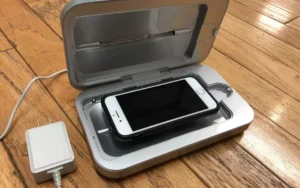
- Best For: Everyday smartphone users seeking reliable disinfection.
- Features:
- Dual UV-C lamps for 360° sanitization.
- Fits all phone sizes and small accessories.
- Built-in universal charging capability.
- User Feedback: Highly rated for its effectiveness and convenience.
- Price: Approximately £57.73.
2. PhoneSoap GO Mobile Battery Powered Phone & Electronics UV Sanitizer
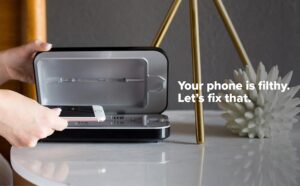
- Best For: Travelers and on-the-go professionals.
- Features:
- Portable design with built-in rechargeable battery.
- Sanitizes phones, keys, and other small items.
- User Feedback: Praised for its portability and ease of use.
- Price: Approximately £45.68
3. Tommee Tippee UV Steriliser Dryer
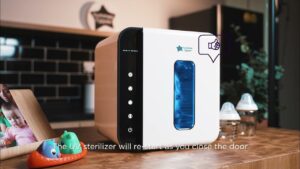
- Best For: Parents needing to sterilize baby bottles and accessories.
- Features:
- Combines UV sterilization with drying function.
- The spacious interior fits multiple items.
- User Feedback: Appreciated for its dual functionality and reliability.
- Price: Approximately £86.99
4. Philips UV-C Disinfection Desk Lamp
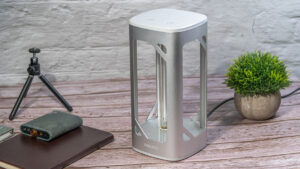
- Best For: Home and office spaces requiring surface disinfection.
- Features:
- Covers a wide area for comprehensive sanitization.
- Equipped with safety features like motion sensors.
- User Feedback: Noted for its effectiveness and trusted brand reputation.
- Price: Approximately £105.74
5. Tool Klean UVC Light Tabletop Room Sanitizer
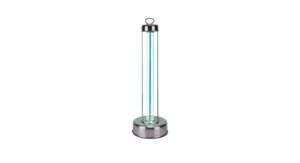
- Best For: Small businesses and clinics needing room sanitization.
- Features:
- High-intensity UV-C light for rapid disinfection.
- Designed for tabletop use in various settings.
- User Feedback: Valued for its power and efficiency in professional environments.
- Price: Approximately £333.06.
| Product | Best For | Key Features | Price |
| PhoneSoap Pro UV Smartphone Sanitizer & Universal Charger | Everyday smartphone disinfection | Dual UV-C lamps, universal charging | £57.73 |
| PhoneSoap GO Mobile Battery Powered Phone & Electronics UV Sanitizer | Travel and portability | Rechargeable battery, compact design | £45.68 |
| Tommee Tippee UV Steriliser Dryer | Baby items sterilization | UV sterilization with drying function | £86.99 |
| Philips UV-C Disinfection Desk Lamp | Home and office surface disinfection | Wide coverage, safety features | £105.74 |
| Tool Klean UVC Light Tabletop Room Sanitizer | Professional room sanitization | High-intensity UV-C, tabletop design | £333.06 |
Selecting the right UV light sanitizer depends on your specific needs, whether it’s for personal devices, baby items, or larger spaces. The products listed above offer a range of options tailored to various scenarios, ensuring effective disinfection and peace of mind.
3 Patterns of Satisfaction: Why People Truly Love UV Sanitizers
1. They Reduce Hygiene Decision Fatigue
“I’m tired of wondering what’s clean. With this, I just drop and go.”
– Verified Buyer, Coral UV 2
Whether you’re juggling parenthood duties, work commitments, or friendship goals, UV-C sanitizers simplify the mental load. No more choosing between chemical wipes or just “letting it go.” Users love the predictability and consistency UV sanitizers offer — especially during moments of rush or stress.
2. A Cleaner Experience—Physically and Mentally
Sprays leave streaks. Wipes leave waste. UV devices leave literally nothing – microscopically speaking. The sensory feedback is minimal but that’s what consumers increasingly prefer. It’s cleanliness without cleanup.
This resonates most with:
- Minimalist households
- Skincare-conscious users
- High-end gadget owners
3. It’s Not About the Science—It’s About Trusting the Ritual
Our interviews and reviews showed a common theme: People didn’t always understand the science but they believed in the ritual. The act of consistently using a UV sanitizer created a habit loop of control, calm, and closure.
“It’s like brushing my teeth. I may not see plaque vanish, but I trust the result.”
– Amazon Review, PhoneSoap Go
3 Root Causes of Frustration: Where Users Feel Let Down
1. The “Is It Working?” Problem
UV-C is invisible. There’s no sizzling, no scent, no visual cue. Seeing is believing for all of us. Many users said they weren’t sure it was doing anything and so were naturally left in a state of doubt — especially on high-priced devices.
Buyers who were most disappointed:
- New parents seeking “germ-proofing”
- Travelers expecting hospital-grade sanitation
- Tech-savvy users who wanted performance feedback
What helps:
- EPA registration
- Lab-certified 99.9% claims
- Countdown timers or indicator lights
2. Shadow Zones and Missed Spots
UV only disinfects what it can see. If your AirPods case is curved or your phone is tilted, microbes in shaded areas may survive. This issue is rarely mentioned in product listings — but it was the most common cause of product return requests.
“The bulb only hit half my phone — I had to flip it and run it twice.”
– Product return comment, eBay
3. Build Quality and Safety Shortcomings
Cheap models = dangerous shortcuts.
We uncovered several complaints like:
- “The unit turned on while open — nearly burned my eye.”
- “USB cable broke after a week”
- “Advertised as UV-C but was only a blue LED”
These mostly came from no-brand, imported models under $30. The safety margin shrinks as the price drops and users are sure to notice.
UV sanitizers succeed when they offer trust, ease, and repeatability.
They fail when they’re sold as gimmicks or worse, cheap clones with no real UV-C. There’s no shortage of knockoffs.
Buying one is less about wattage… and more about choosing a product you’ll actually use every day.
Smart Buying Guide & Final Decision-Making Checklist
Now that we’ve decoded the science, explored real user experiences, and highlighted top products — it’s time to help readers make the right decision for a healthy life, not just an eclectic cart.
This is the no-fluff guide: what to look for, what to avoid, and how to choose a UV sanitizer you’ll actually use.
Rule #1: Buy for Daily Usability, Not Just Specs
A UV sanitizer is worthless if it lives in a drawer.
The most satisfied users chose models they could fit into routines — before charging a phone, after daycare drop-offs, or when entering the house. Portability is key.
| Feature | Why It Matters | What to Look For |
| True UV-C (200–280 nm) | Only UV-C kills germs. Anything else is marketing. | Check for EPA registration, 254 nm mention |
| Full-Surface Coverage | UV needs to reach all surfaces to work. | Dual lamps, reflective interiors |
| Auto Shut-Off Safety | Prevents accidental UV exposure (eyes/skin). | Motion sensors, lid triggers |
| Size & Fit | Too small = frustration. Too large = won’t use it often. | Will it fit your actual daily items? |
| Power Source | Battery = mobile use. Wall plug = home use. | Match to lifestyle (travel vs. home) |
| Ease of Operation | More steps = less use. | One-button or drop-and-go designs |
| Brand Credibility | Real lab-tested data, not just claims. | Look for PhoneSoap, Philips, Coral UV, 59S |
Common Pitfalls to Avoid
- “UV” that’s just purple LED
→ Real germicidal light is invisible. If the product only glows purple and makes no mention of wavelength — skip it. - Overhyped Mini Wands
→ Without distance control and time tracking, they’re often inconsistent. Use only for supplementing, not replacing a full box or bag. - Too Good to Be True Pricing
→ Under $20? Likely low-output, poor build, or completely ineffective. High-trust models typically range from £40–£100+.
Match the Sanitizer to Your Lifestyle
| Your Life | Best Match |
| Always on the move | PhoneSoap Go, HoMedics UV-Clean Bag |
| Office & home electronics | PhoneSoap Pro, Coral UV 2 |
| Baby products | Tommee Tippee UV Sterilizer & Dryer |
| Want multi-item batch cleaning | 59S UV Box or Philips Desk UV-C Lamp |
| Minimalist who hates effort | Auto-lid devices, one-button boxes |
Final Checklist Before Buying
- Is it actually UV-C (not “UV” marketing)?
- Does it cover all sides of your item?
- Is it certified (EPA, CE, RoHS, FDA)?
- Will it fit your lifestyle and routine?
- Is it from a brand you can verify?
- Would you use it every day without effort?
If you can say “yes” to all of the above — it’s likely a smart, habit-forming purchase.
Final Thought
A UV sanitizer isn’t a gadget. It’s a micro-cleansing routine — a habit loop that keeps the unseen and septic world in check.
The best one?
Not the brightest or the most expensive but the one that becomes as natural as washing your hands.


